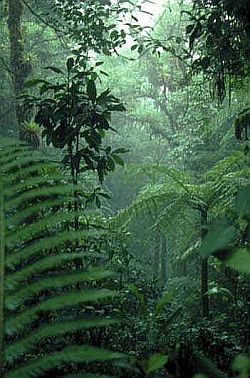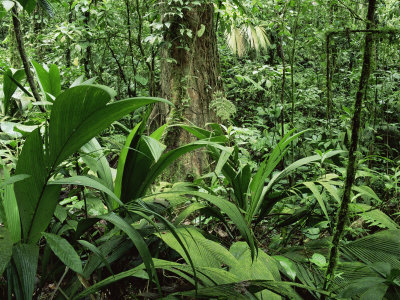Falyndar
From Mizahar Lore
The region of Falyndar is filled with thick jungles and plenty of the most dangerous creatures in Mizahar. It is a region in which only the strong survive, and only the foolish venture unaware and unescorted. Few that enter the region ever emerge alive... if they emerge at all. In Falyndar, travelers have the feeling of being watched. Shadows from the foliage, maybe... but it's always safer to assume that someone... or something... is watching you.
Contents |
History
Before the Valterrian, the region that was Falyndar was actually the southwestern area of the Suvan Empire. Inhospitable and untamed, the people of Suvan left it alone after attempts to explore it failed miserably. But there were always stories... stories of savage cannibals that sowed the jungle floor with blood, where screams of both agony and triumph rent the air at any given time.
Eventually stories emerged outside of it, told around flasks of booze in taverns by ragged explorers who had stared death in the face. "They... they ate Jacobi... ate him alive."
Vicious, bloodthirsty tribes roamed the jungle, and they battled each other constantly. It was a state of war - no tribe held dominion over any other. They killed each other over territory, over pride and respect, over resources. One tribe eventually gained, and held, control over the area. A new capital, Taloba, was established in the middle of the jungle, and its leader was supposedly favoured by a number of gods.
The Myrian population was severely diminished after the Valterrian - going down from as high as perhaps 65,000 at some estimates to only about 12,000. The survivors set to work rebuilding Taloba, and exploring what had become of their jungle. What had been troublesome before was truly nasty now, and the Myrians discovered, much to their shock and anger, that other races had set up camp in their ancestral home. This they would not stand for, and set to work purging the jungle of these intruders. The wolfish Tupahi, the slender Ukantsu, the purple-skinned Waorori, the winged Jollai, the wizened Pepao, and the reptilian Gwanah... one by one, they were hunted, down to the last, and destroyed.
The Charodae wisely chose to stay away from the land, living far below the surface of the water rather than provoke the dark-skinned warriors into genocide; the small population of the Dhani in the northwest has shrunk considerably, consisting of only a few hundred individuals. But the Myrians will not rest until the jungle is theirs again.
Geography and Climate
Falyndar is a lush, tropical jungle through which travel is quite difficult for outsiders. Few ever find the paths created by the Tskannas, and none but the Myrians possess the versatile Myrian Tigers who are capable of traveling easily, and swiftly, through the dense jungle. A number of streams cross over the land, adding to the richness and health of the flora and fauna. It is filled with peaks and valleys, many of which hold any number of traps for the uninitiated. Within the humid depths, one might come across a pool of wild magic, guarded by the Myrians who plumb their secrets for their own use and gain.
The coasts, too, are flanked with heavy vegetation, and have only small areas of sand in the east, and none in the west. The northern reaches give way to harsh, rocky hills and mountains as it approaches Kalea. Whirlpools are prone to coming into existence off of the coast, particularly near Black Rock, the small island off of the eastern coast. Black Rock is completely different from the rest of Falyndar, being the home of the Goddess of Death, Dira.
While rain is common throughout the year, it is particularly heavy during the summer, when temperatures are higher still. With the exception of summer, the seasons in Falyndar blend together. Were it not for the Watchtowers, time might go unnoticed.
Places of Interest
Demographics and Politics
Despite the number of Gods who inhabit, or regularly visit Falyndar, the de facto ruler of the region is the Goddess-Queen Myri. She rules from Taloba, the home of the Myrians. The Myrians severely outnumber the other races of Falyndar, and their numbers are continuing to grow. The Dhani are ruled by their Queen Snhamtanabis in Zinrah. Dira has total control over Black Rock, and is a close ally of Myri. The Charodae have their own council deep within Charbosi.
Native Peoples
After the Valterrian, Falyndar became home to almost a dozen different peoples, all of them new... except for one. Now, only three native races remain, two of which exist in a constant a struggle to survive the harsh realities of the jungle and the third.
Falyndar's peoples are the following:
Wildlife and Creatures of Note
Falyndar is home to an incredible expanse of wildlife, from the smallest bugs to the massive tskannas. It is not unusual to start the day, or retire in the evening, to the screams of the wild predators, or the flock calls of the beautiful parrots and birds that reside throughout the thick jungle. Colourful frogs appear one moment, and are gone the next, leaving one wondering just where it disappeared to. Lazy-looking, mossy creatures can sometimes be spotted dangling from limbs in the canopy. A pair of feline eyes might glow in the dark, watching from the shadows, waiting for the unwary to rest for the night. A bird call may belong to a bird... or it may not. Many a Myrian has happened upon an explorer that way, confusing them as their enormous mounts catch them unawares.
Many species, both plant and animal, in Falyndar have experienced dirism as a result of the Valterrian. While these creatures may have been enormous in their own right, these monsters are huge, and hunting them is considered a great honor and proof of one's skill.
The following are only found in Taloba, or with Myrians:
The following are only found in Charbosi, or with Charoda:
The following are only found in Zinrah, or with Dhani:
Falyndar Fauna List
Plant Life
Because of the unique ecosystem in Falyndar, there are numerous plants that cannot be found anywhere else. Often brightly coloured, they catch foreigners by surprise with their toxicity. The qallos fruit, for example, looks like perfectly normal cherries, only to be deathly poisonous to non-Myrians. Take nothing for granted.


